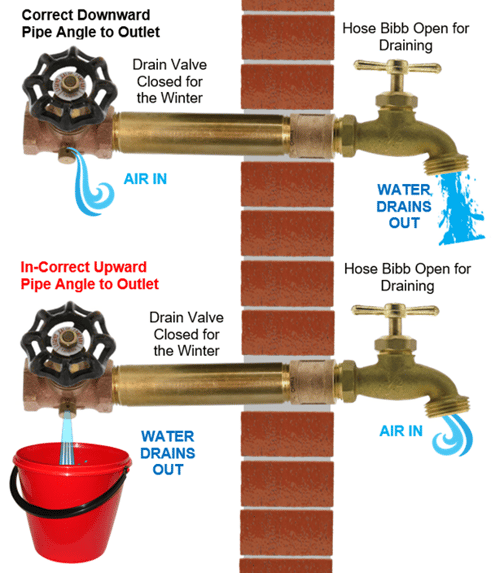Are “hose bibb” faucets frost-free?
No, traditional hose bibbs are not frost-free!
The term hose bibb is often confused in the plumbing industry. It simply refers to a faucet having a nozzle bent downward, also referred to as a bibcock. There can be confusion because the hose bibb, in most cases, indicates that the faucet has a ¾” garden hose thread (GHT) connection on the downward facing nozzle (outlet spout). This is to attach a garden hose. Similar looking valves without the garden hose thread are sometimes also called hose bibbs. Boshart calls these valves “sampling faucets” to avoid confusion. See the SSSF52 and 0874 series photos below.
Hose bibb valves are sometimes referred to as sediment faucets or boiler drains. They are available in several materials, brass, stainless steel, and PVC. They are manufactured in two basic designs, the multi-turn and the quarter-turn type valves.
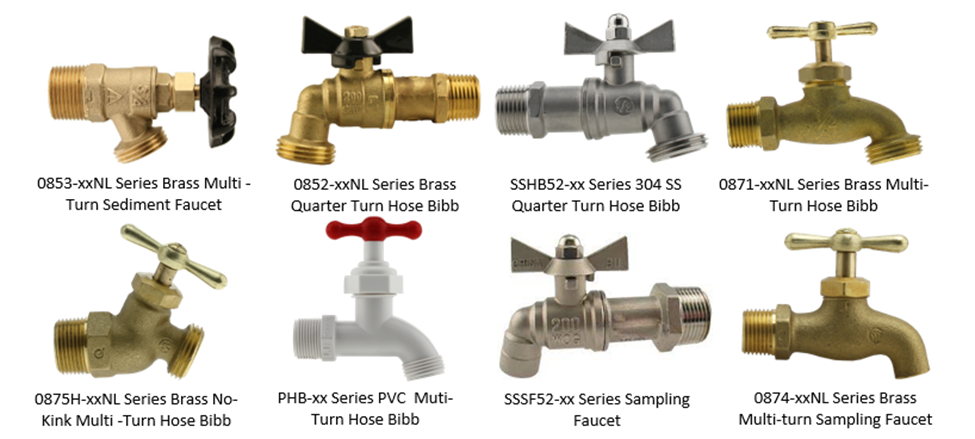
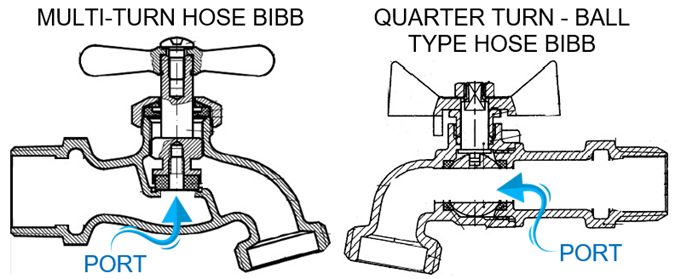 WARNING:
WARNING:
The above hose bibb valves are designed with the valve port close to the outlet spout. The entire valve WILL freeze when installed on the outside wall of the house or building when temperatures drop to the freezing point.
CAUTION:
Do not confuse hose bibbs with non-freeze wall-hydrants or non-freeze lawn faucets which also have a garden hose connection.

A frost-free wall hydrant has a long tube so that the shut off is inside the home in the heated area. These valves can be used in the cold season since the long tube drains all the water back to the valve port in the heated zone of the home after each use. NEVER LEAVE A HOSE ATTACHED IN COLD WEATHER.
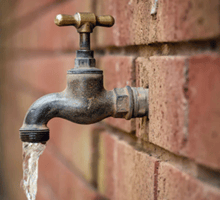 Can hose bibbs be installed on outside walls?
Can hose bibbs be installed on outside walls?
Yes, they can be used for the outdoor applications. However, it is crucial that a drain system for winterization is installed. The supply line and valve MUST be drained/winterized for the cold season to prevent it from freezing and bursting.
What is a drain system?
The drain system requires either a stop & waste (drain) valve or a ball valve with drain to be installed inside the home in the heated/no freeze zone. These valves have a drain cap that can be opened which allows air into the supply line. This ensures all of the water is drained out of the supply line and goes out through the wall to the hose bibb faucet when the cold weather arrives.
Possible valve options with drain feature:
Stop and waste valves series 0844, 0844C, 0844CPR.
Ball valves with drain series 082WD, 082WDC,082CP, 0821WDP.
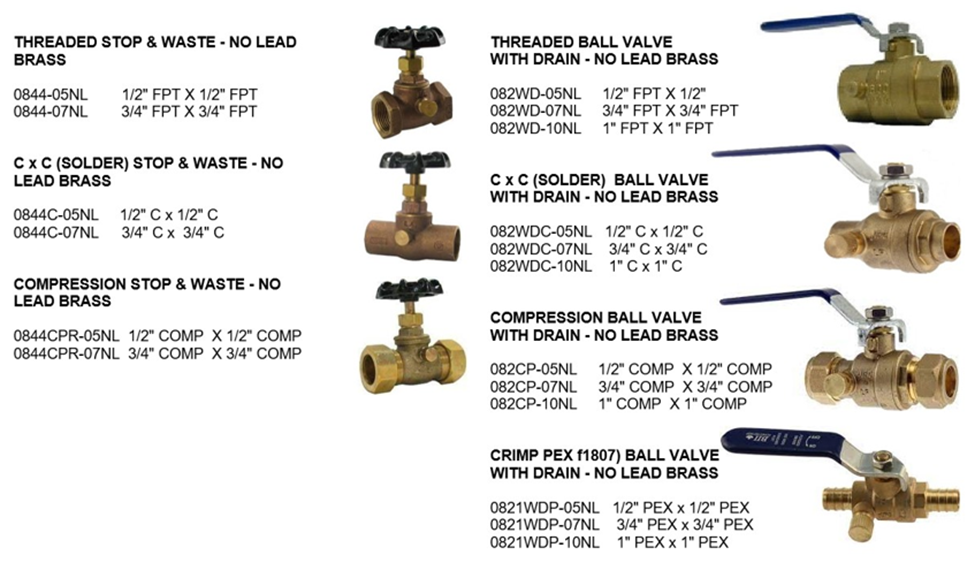
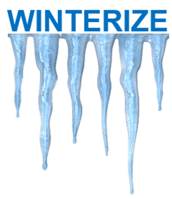 Winterizing your Outdoor Hose Bibb Faucets
Winterizing your Outdoor Hose Bibb Faucets
The old saying that an ounce of prevention is worth a pound of cure is truly relevant when it comes to avoiding expensive water damage. A few minutes to prepare your outdoor faucets each fall for winter season is all it takes.
STEP #1
Locate all the outdoor faucets with a quick walk around the building perimeter. Remove all hoses or other devices, such as irrigation timer valves, that may be attached to the hose bibb connection.
STEP #2
 Locate all the shut off valves inside the home or building in the supply lines at each hose bibb faucet. The shutoff valve with a drain is normally at the ceiling of the basement just inside where the faucet supply line goes out through the wall.
Locate all the shut off valves inside the home or building in the supply lines at each hose bibb faucet. The shutoff valve with a drain is normally at the ceiling of the basement just inside where the faucet supply line goes out through the wall.
These valves are designed with a drain feature and could be either a stop & waste valve or a ball valve with drain (quarter turn, lever type). Newer construction typically has the lever-style ball valves, whereas older systems typically will have standard faucets (stop and waste type valve).
Regardless of the type, this valve has a bleed cap to allow drainage of the water out of the supply pipe and the outdoor faucet. If the shut-off valve does not have a drain feature it should be replaced with one that does. Compression type valves are a great solution for copper lines as no heat is required.
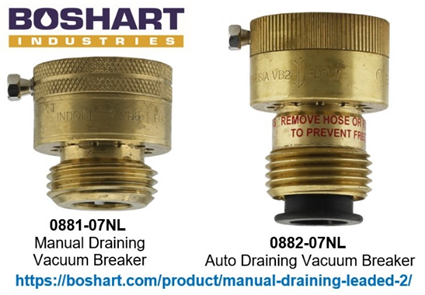 If the outdoor hose bibb is fitted with a manual drain vacuum breaker 0881-07NL you will need to hold the vacuum breaker open until it quits dripping. This will not be required if it has an 0882-07NL auto-draining vacuum breaker.
If the outdoor hose bibb is fitted with a manual drain vacuum breaker 0881-07NL you will need to hold the vacuum breaker open until it quits dripping. This will not be required if it has an 0882-07NL auto-draining vacuum breaker.
STEP #3
Close all the shutoff valves, then go outside and open all the faucets to drain the water. Some of the water will drain out. However, you must go back inside to the shutoff valves and remove the bleeder/drain cap to break the air lock which will allow the remaining water to drain out of the pipe. It is a good idea to have a pail to hold under the drain/bleeder port to catch the water. When fully drained replace the drain/bleeder cap and close the outside faucet.
What if the shut off does not have a drain feature?
Older homes often do not have the proper indoor shutoff valves for outdoor faucets. You may wish to install a valve with a drain feature or even better replace the outdoor valve with a non-freeze or frost-free wall hydrant (a.k.a. lawn faucet) that allows you to leave the water on year-round. It is recommended to install a wall hydrant that has a built-in vacuum breaker.
If the outdoor valve is a non- freeze wall hydrant type with an aftermarket vacuum breaker, the manual type of vacuum breaker will require that you hold the drain tab to the side to allow the wall hydrant to drain. Whereas an auto-drain vacuum breaker will open and allow the hydrant to drain when the hose is removed. Again, you may want to consider upgrading to a non-freeze or frost-free wall hydrant with a built-in vacuum breaker. This would allow you to leave the water on year-round and will drain without any issues which add on vacuum breakers may have.

Additional Resources:
https://support.boshart.com/should-i-install-a-vacuum-breaker-on-my-faucets-hose-bibb-connection
https://support.boshart.com/what-is-the-lowest-temperature-that-wall-hydrants-are-rated-for
https://support.boshart.com/how-do-i-repair-a-leaking-or-malfunctioning-wall-hydrant

